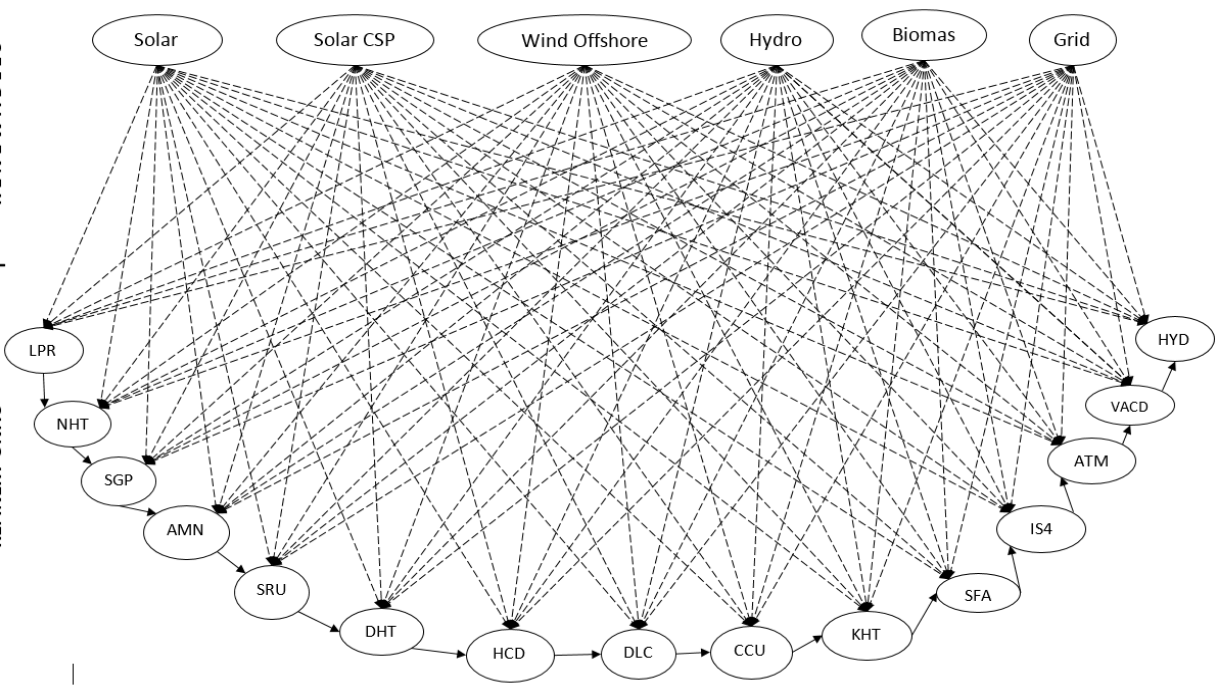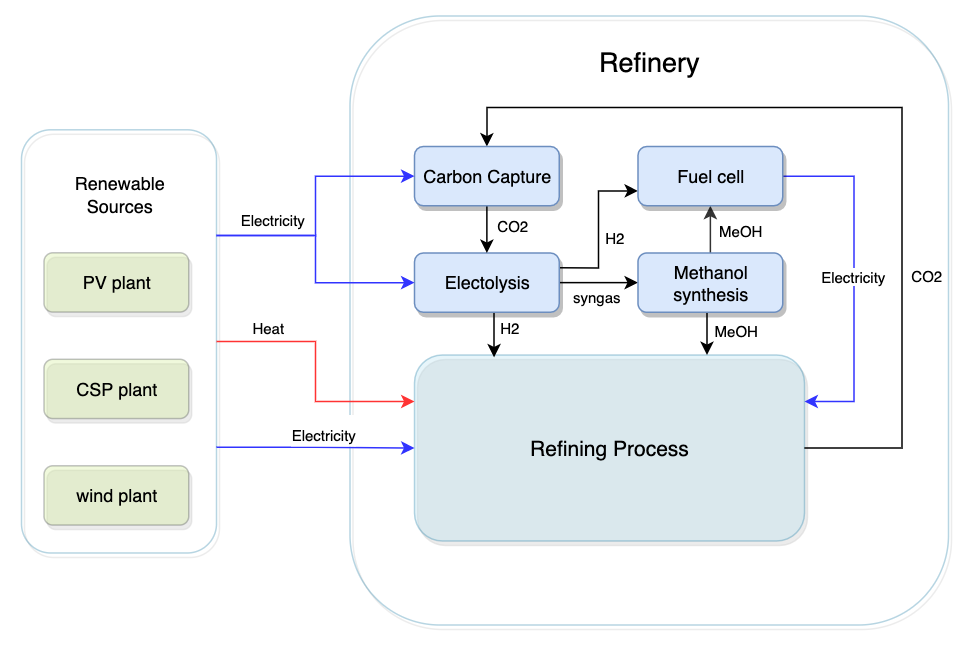2 Optimal renewable integration in a refinery
Internship
Autumn 2022
This is an internship project in Paris co-supervised by TotalEnergies and IPESE. This project aims to investigate the pathway of integrating renewables (PV and wind, etc.) in a refinery and the results have the possibility to be validated by a real case study provided by TotalEnergies. The candidate is expected to start before 2023.
2.1 Context
In response to the climate change, TotalEnergies, one of the biggest oil and gas companies in the world, adopted a Climate Ambition in 2020, addressing the target to achieve net zero across its worldwide operations by 2050 or sooner. Among all the operations, refinery was one of the most concerned, due to its large quantity of carbon emissions and its central position in maintaining a stable energy market by converting crude oil into fuels and feedstocks. In 2018, refinery process alone accounted for 40% of emissions from the oil and gas supply chain and 6% of all industrial carbon emissions (“World Energy Outlook 2018 – Analysis” n.d.).
There are a number of technologies that offer potential ways to mitigate the CO\(_2\) emissions at refinery, including clean hydrogen and carbon capture and storage (CCS). These technologies, despite their positive impacts on carbon density reduction, are actually largely dependent on steady and reliable clean electricity with low carbon footprints. Clean electricity is the key enabler and solid backing for refinery decarbonization.
Compared with solely importing electricity from grids, direct renewable integration has the potential to achieve highly efficient heat and power cogeneration. From the perspective of renewable sources, their intermittency can be mitigated or fully eliminated by the hydrogen demand and power generation in refinery, instead of relying on expensive batteries or other storage technologies. Last but not least, the renewable integration has the possibility to strengthen the energy security given that the stable operation is always one of the highest priorities for refinery.
In conclusion, this project aims to investigate the optimal pathway of renewable integration into a refinery. Various renewable sources, such as photovoltaics, concentrated solar power and wind energy, and their integration methodologies will be evaluated in the aspects of costs, environmental impacts and renewable intermittency. This project, which will be co-directed by TotalEnergies and IPESE at EPFL, has the potential to leverage the strengths of each part by applying the advanced research results into real-world industrial applications.
2.2 Literature review
A plenty of studies and projects have been conducted on the renewable integration in general industry sectors. A report published by IEA in 2017 [2] reviewed and analysed 21 case studies of renewable integration on industrial sites and summarized 8 main issues for renewable integration, which are (1) energy production regulatory regime, (2) operability, (3) investment, (4) return on investment, (5) risk and insurance, (6) Contractual scheme complexity, (7) technology maturity and (8) awareness. They tried to look for solutions to these issues from the policy perspective and addressed the environmental benefits brought by renewable integration (Galichon et al. 2017).
Specifically for oil and gas operations, the National Renewable Energy Laboratory in the US concluded that variability generation, system reliability and operability were three main constraints for renewable integrations. However, despite all these incoming challenges, the authors believed that the role of renewable generation in oil and gas operations could greatly increase and help both cost and emission reductions (Ericson, Engel-Cox, and Arent 2019).
To the author’s knowledge, the studies of renewable integration in a refinery are still limited to power integration under simple superstructure schemes. Alnifro et al. (Alnifro 2017) at University of Waterloo proposed a superstructure method to optimize the electricity usage in various refinery processes. As shown in Figure 2.1, they applied a linear programming to select the optimal connections between renewable sources and refinery processes to optimize both environmental impacts and costs. In this study, the potential benefits brought by heat integration were not considered.
Figure 2.1: Superstructure diagram for the crude oil refinery units connected with all available energy resources proposed by Alnifro et al Alnifro (2017)
Recently, Switzerland-based Varo Energy Group and Groupe E announced the construction of a 7.7MW PV power plant to support the refinery’s medium-voltage operation, releasing the signal that integrating renewable in a refinery has become commercially viable (“Switzerland’s Largest Solar Park Planned to Power Refinery” n.d.).
2.3 Problem statement
Based on the literature studies, it is possible to envision the future refinery that leverages renewable power to decrease costs and maximize production while reducing environmental impacts. However, the studies and practices are still in a primary level today, only considering the power demand and ignoring the deep integration opportunities with heat and hydrogen production.
A possible scenario of renewable integration in refinery is presented in Figure 2.2. Cogeneration of heat and power is considered for the refining process. In addition, the surplus electricity is used for carbon capture and electrolysis process. The captured CO\(_2\) can be co-electrolyzed with H\(_2\) to produce synthetic gas for further methanol production. The produced H\(_2\) is either used for refining process or for electricity generation in fuel cells.
Figure 2.2: A possible scenario of renewable integration in refinery
The mission of the internship will be focusing on the completion of the conceptual study and identify the economically and technically feasible pathway of integrating renewable in a refinery. The questions to be answered in this project include:
What will be the potential technologies to be integrated into a refinery? What are their advantages?
Identify the barriers to renewable integration. The barriers may include:
How to deal with the intermittency of renewable energies?
How to keep the system realiable and operable with renewble integration?
What are the transition pathway from the current refinery to the refinery with renewables?
What are the suitable sustainability metrics to compare and optimise the generated pathways?
How to improve the work? How to validate the results?
2.4 For candidates
The successful candidate is expected to have the following profiles:
High-level motivation and ability to work in an autonomous environment.
Good knowledge of energy systems and renewable technologies.
Coding skills (Python or Matlab) are a plus.
System thinker and problem-solver oriented.
The candidate will develop different competencies, such as project management experience in a large company, technical knowledge with renewables and mathematical optimizations, and critical thinking skills, etc.
2.5 Supervising
This project will be jointly directed by TotalEnergies and EPFL. The candidate will be supervised by a manager from TotalEnergies and Prof. François Maréchal from EPFL. Yi Zhao will serve as the assistant for this project.
If interested, please take contact with Yi Zhao (yi.zhao@epfl.ch) attaching your CV, Cover Letter and transcript of records (Bachelor’s and Master’s). Short-listed candidates will be interviewed. Early applications are encouraged.
2.6 Practical information
The IPESE group is located in Sion (EPFL Valais) at about 1h05 from Lausanne train station. The transportation fees between Lausanne and Sion will be reimbursed by the lab.
TotalEnergies is a company headquartered in Paris. The successful candidate will receive financial supports for this projects. The necessary travel expenses between France and Switzerland will be reimbursed.